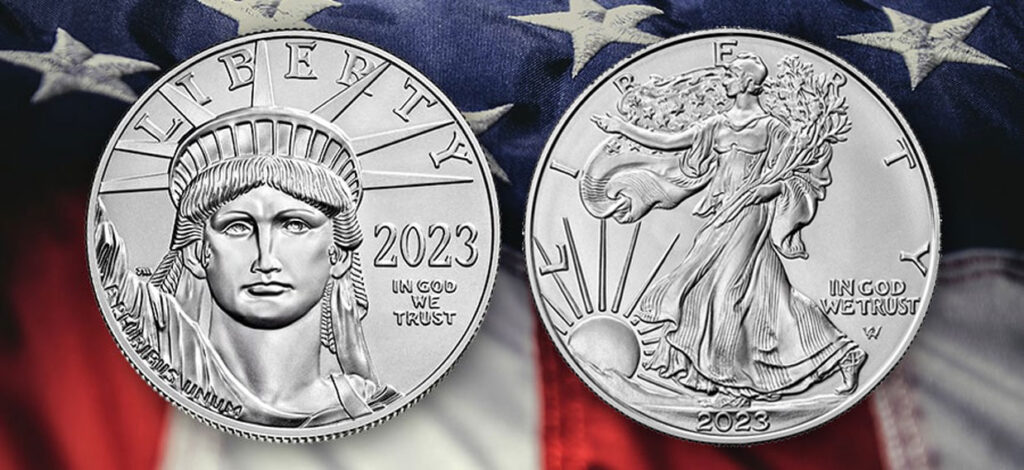 Platinum and silver are two valuable precious metals that are difficult to tell apart to the untrained eye. However, these physical metals differ significantly in various ways including value, physical characteristics, market conditions, histories, and investment considerations.
Platinum and silver are two valuable precious metals that are difficult to tell apart to the untrained eye. However, these physical metals differ significantly in various ways including value, physical characteristics, market conditions, histories, and investment considerations.
Platinum vs Silver: Similarities
Inflation Hedge
Platinum and silver can offer investors a reliable hedge against inflation. While stocks, mutual funds, ETFs, bonds, and other paper assets can be subject to volatile market conditions, physical assets have inherent value based on their precious metal contents. The prices of platinum and silver products are generally more stable in the face of market uncertainty and unpredictability.
High Purity
Purity refers to the percentage of an asset’s composition that consists of the designated precious metal. The higher the purity, or fineness, the more valuable the coin. Platinum and silver have exceedingly high purity ratings, offering maximum inherent value and optimized protection for investors. For example, American Platinum Eagles have a 99.95% purity rating while American Silver Eagles clock in at 99.99%.
IRA Eligibility
Investors can make platinum and silver part of their retirement plan through a precious metals IRA. This unique form of retirement account permits the holding of physical assets for a more diversified nest egg. However, platinum and silver assets must still meet strict fineness, weight, and asset type requirements set forth by the IRS.
👉 Further Reading: Find out precisely what the government counts as eligible precious metals for IRA investing
Platinum vs Silver: Differences
Appearance
The visual similarities between platinum and silver assets have been tripping up people for centuries. In fact, the term platinum is derived from the Spanish word “platino” which means “tiny silver” because early Spanish explorers acknowledged how closely it resembled silver. Both precious metals have distinct luster, but platinum tends to reflect light more brightly than silver. Furthermore, silver is more prone to corrosion which can impact the sheen of older silver assets. A quick way to distinguish platinum and silver bars is to look for purity markings which usually mention the fineness rating along with the type of metal.
Value & Price
The staggering price gap is one of the first differences investors notice when comparing platinum vs silver. While platinum prices have hovered around $1,000/oz for the past few years, silver prices have remained just above $20/oz. It’s crucial to bear in mind that the current market rate of a precious metal isn’t indicative of its investment merit. The disparate evaluations in terms of price-per-ounce vary between platinum and silver for a variety of reasons including supply and demand, market size, and historical price performance.
Price Performance
Historically, silver boasts a much steadier price performance, offering investors more financial stability and predictability. On the other hand, platinum tends to experience more volatility due to its considerably smaller market. With fewer trades happening, it doesn’t take much to jostle the market which can send prices tumbling or skyrocketing. Another cause of platinum’s unsteady price action is its monopolized production. South Africa, Russia, and Zimbabwe account for over 92% of platinum mining, giving these unpredictable regions immense influence over supply and, as a result, price performance.
Scarcity
Rarity is another important difference between platinum and silver which heavily influences the varying evaluations and price action of these metals. Currently, worldwide supplies of platinum amount to 5.8 million ounces while silver supplies reach over 1 billion ounces. That means silver is more than 172 times more available than platinum. This massive difference in scarcity is the principal driving force behind platinum’s exceedingly high price per ounce when compared to silver.
Industrial Demand
Platinum and silver share a number of useful physical characteristics including malleability and high conductivity of heat and electricity. These unique properties are highly sought after in various industrial applications. However, silver’s more affordable price point makes it the preferable metal. Besides its high price tag, platinum’s scarcity and unpredictable supply represent considerable obstacles to widespread adoption.
Liquidity
The combination of a larger market, stronger demand, and higher affordability makes silver a favored choice for those seeking quick and efficient transactions in the precious metals market. Silver’s higher liquidity gives investors greater investment flexibility when compared to platinum which suffers from restrictive and unpredictable supplies. Additionally, silver’s lower cost-per-ounce opens investors up to a broader market of buyers further increasing this shiny metal’s liquidity.
Asset Diversity
Silver’s accessibility, price stability, historical demand, and reliable supply have secured its popularity above platinum. This difference in demand is reflected in the diversity of products available containing each precious metal. Generally, private and public mints produce more silver bullion assets in the form of bars and coins when compared to platinum products. Furthermore, there are significantly more silver investment-grade coins due to this precious metal’s use in circulating coinage. Overall, silver represents a richer trove of asset diversity for investors, making it easier to find products that meet varying needs and budgets.
Platinum vs Silver: Which is the better investment?
Silver enjoys more popularity than platinum for several reasons including a lower barrier of entry, greater demand, higher liquidity, and steadier price performance. However, the ultimate determination of the “better” investment requires an assessment of each investor’s specific investment circumstances.
If you’re interested in learning more about diversifying with physical metals, grab a FREE copy of our Precious Metals Investment Guide. It’ll explain everything you need to know about choosing the right metals for a properly diversified and secured portfolio.


